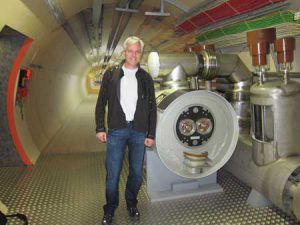
By Andreas Warburton
“If it’s just a fluctuation of background, it will take a lot of data to kill.”
Dr. Fabiola Gianotti, spokesperson for our A Toroidal LHC Apparatus (ATLAS) collaboration, uttered these words on Dec. 13, 2011 during a special seminar I attended at the European Organization for Nuclear Research (CERN) laboratory in Geneva, Switzerland. Within the minute that followed, I hurriedly concocted a tweet, tacked on #Higgs and #CERN hashtags, and sent Fabiola’s weighty comment off into the WWW.
CERN, where the WWW was invented, is the main European particle physics laboratory. I was at the lab for a week to discuss physics and the detector performance of our ATLAS experiment, a 7,000-ton apparatus we use to examine remnants of high-energy proton collisions delivered by CERN’s 27-km Large Hadron Collider (LHC), straddling the Franco-Swiss border.
This turned out to be no ordinary week. The 2011 LHC program had yielded a fecund data sample, and we needed to take stock of our most promising new-phenomena searches. By far the most anticipated were the Higgs boson particles, hypothetical pieces in the emerging puzzle of the tiniest known subatomic particles. Signal rumours had been swirling around the planet in blogs and other media. I was asked by McGill Media Relations to live tweet the Higgs update event. I already knew our ATLAS measurements, but was keen to see results by our competitors, the CMS collaboration, running a complementary detector on the French side of the LHC. Exciting times!
We owe much of this excitement to Ernest Rutherford who, while a McGill professor of Experimental Physics early last century, unwittingly helped to kick off the Higgs hunt through his Nobel Prize work on radioactivity. Modern theories that posit the existence of one or more types of Higgs particles seek to unite – into a more symmetric and fundamental theory – two basic forces: 19th-century electromagnetism and Rutherford’s 20th-century radioactivity. As if that weren’t enough, observing Higgs particles would also help to reveal a mechanism by which various fundamental particles are endowed with their non-zero mass values. This gets at the very essence of the physical universe.
More recently, my McGill colleagues and I have been searching for Higgs bosons using the Tevatron matter-antimatter collider near Chicago. Just last summer, McGill’s Dr. Adrian Buzatu defended a PhD thesis using Tevatron data to set the world’s best limits on Higgs boson production in the mass region that is now revealing hints at the LHC.
In December, I entered CERN’s auditorium three hours before the seminar was to begin. Within about 30 minutes, all available seats and aisles were jammed. A mob formed outside the auditorium door, but security guards were able to maintain control. Unable to work in all the nervous energy and jostling, I tweeted, “You’d think it was John Lennon coming to CERN today.”
At long last the ATLAS and CMS talks began. Both collaborations had searched extensively for several different signatures, scenarios by which a Higgs particle could be created from LHC collision energy before disintegrating into lighter particles.
Given our detectors’ sensitivities, and the colossal Higgs-mimicking backgrounds, we knew in advance that our samples wouldn’t suffice for a statistically robust 2011 discovery. Nevertheless, both ATLAS and CMS showed suggestive traces in a variety of Higgs signatures. Enticingly, both collaborations ruled out overlapping mass ranges and recorded hints at similar masses.
These indications are thrilling. In this kind of science, discoveries take time and are often preceded by whiffs. We’re also cautious. Our 2011 results could be chance background fluctuations, tantamount to tossing six coins and getting tails every time. Only when our observations are flukier than tossing 20 tails in a row will we claim a discovery.
The 2012 data will likely enable us to observe or rule out the Higgs boson. Either of these outcomes constitutes exhilarating, 21st-century science. I look forward to tweeting about it.
For the event’s archived tweets, which contain links to further information, go to www.physics.mcgill.ca/~awarburt/Warburton_McGill/Higgs_CERN.html.
Andreas Warburton tweets as @AWarb and is an associate professor in McGill’s Department of Physics. For information about his research and other interests, see http://twitter.com/#!/AWarb. The McGill ATLAS group consists of 4 faculty, 3 postdocs, 9 graduate students, and 2 undergraduates.
